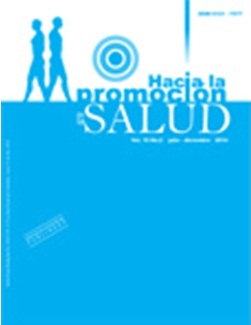Authors
Abstract
Objectives: To investigate the social construction of the health concept through the exploration of meanings, cognitive dimensions and cultural consensus in workers retired from the Instituto Mexiocano del Seguro Social, with the intention to contribute with meaningful data for the design of intervention and health promotion actions. Material and methods: qualitative study with descriptive, cross-sectional and exploratory design. It was carried out in the Metropolitan Area in Guadalajara, Jalisco, Mexico, between January and August, 2009. The data collection techniques were "free list" and "pile sort" methods in successive stages with 20 people each. Cultural domain analysis was performed. Results: the health concept was defined mainly through the well-being concept. The cognitive dimensions of the concept revealed a very wide and complete vision in retired people which included the search for personal independence and the balance of the physical, mental, emotional, spiritual and social aspects where economy was identified as a conditioning aspect for them to be at ease and healthy. Cultural consensus at a rate of 3,888 and an average of cultural competence at 0.512 was observed. Conclusions: the elements to be considered in the health intervention and promotion programs cover a comprehensive perspective. They include adequate food, medical prevention and attention, exercise, outdoors activities, fun, rest, maintenance of internal health, stimulation of self-acceptance and enjoyment of social relations and religious believes. Because of the absence of altruistic elements, the promotion of supporting activities for vulnerable groups is recommended.
Keywords
References
Lejarraga A. La construcción social de la enfermedad. Archivos Argentinos de Pediatría. 2004;102(4):271-276.
Bazo MT. La institución social de la jubilación y las personas jubiladas. Revista del Ministerio de Trabajo y Asuntos Sociales. 2000:241-255.
Canes C, García RM. Perfil del anciano del año 2000. Revista Española de Geriatría y Gerontología. 1989;(24):335-341.
De Zayas I. El reto de la atención socio-asistencial de los nuevos jubilados. En IV Jornadas de Intervención Social del Colegio Oficial de Psicólogos de Madrid. 1996;(3):2365-2373.
Lizaso I, Sánchez M, Reizábal L. Factores psicológicos y salud asociados con un nuevo perfil de jubilados. Revista Psicología del Trabajo y las Organizaciones. 2008;24(3):303-324.
Meléndez JC. La percepción de posibilidades personales: ¿existen diferencias entre prejubilados y jubilados? Gerokomos. 1996;(7):109-114.
Téllez V, Reyes D. Jubilación, envejecimiento y espacios alternativos de participación social. Santiago. 2004;(104):102-105. Disponible en: http://www.uo.edu.cu/ojs/index.php/stgo/article/view/14504207/831
Flores-Guerrero R. Salud, enfermedad y muerte: lecturas desde la antropología sociocultural. Revista Mad. 2004;(10):1-8. Disponible en: http://www.revistamad.uchi le.cl/10/paper03.pdf
Austin TR. Para comprender el concepto de cultura. Revista UNAP Educación y Desarrollo. 2000;1(1):1-10. Disponible en: javeriana.edu.co/personales/jramirez/PDF/Austin-pcecdec.pdf
D’Andrade R. The development of cognitive anthropology. Cambridge, UK: Cambridge University Press; 1995.
Weller S. Cultural Consensus Theory: Applications and Frequently Asked Questions. Field Methods. 2007;19(4):339–368.
Boster JS. Introduction. American Behavioral Scientist. 1987;31(2):150-162.
Romney K, Batchelder W, Weller S. Recent applications of cultural consensus theory. American Behavioral Scientist. 1987;31(2):163-177.
Romney K, Boyd JP, Moore C, Batchelder W, Brazil TJ. Culture as shared cognitive representations. Proceedings of the National Academy of Sciences. 1996;(93):4699-4705.
Torres TM, Aranda C, Pando M, Salazar JG. Dimensiones conceptuales del bienestar de personas con padecimientos crónicos. Revista de Salud Pública y Nutrición RESPYN. 2007;8(4):1-8. Disponible en: http://www.respyn.uanl.mx/viii/4/articulos/bienestar.htm
Torres TM, Munguía JA, Pozos BE, Aguilera MA. Representaciones sociales sobre la salud y la enfermedad de la población adulta de Guadalajara, México. Aten Primaria. 2010;42(3):154–161.
Aguilera MA, Torres TM. Vivencias de jubilación y prejubilación en odontólogos. Revista de Salud Pública y Nutrición RESPYN. 2008;9(1):1-8. Disponible en: http://www.respyn.uanl.mx/ix/1/index.html
Alarcón AM, Vidal AC. Dimensiones culturales en el proceso de atención primaria infantil: perspectivas de las madres. Salud Pública de México. 2005;47(6):440-446.
Helman C. Culture, health and illness. Oxford: Butterworth-Heinemann; 1994.
Hanhn R. Sickness and healing: An anthropological perspective. New Haven: Yale University Press; 1995.
Bryant J. Health and developing world. Cornell: University Press; 1975.
Kleinman A. Patients and healers in the context of culture. Berkeley: University Press, 1980.
Romney K, Weller S, Batchelder W. Culture as consensus: A theory of culture and informant accuracy. American Anthropologist. 1986;(88):313-338.
Weller S, Romney K. Systematic Data Collection. Newbury Park, Beverly Hills, London, New Delhi: Sage; 1988.
Chevalier JM. Listados libres y clasificación por montones. Sistemas de Análisis Social 1.0. 2006. Disponible en: http://www-sas-pm.com/
Coxon AA. Sorting data: Collection and analysis. Thousand Oaks, CA: Sage; 1999.
Borgatti SP, Halgin D. Guía del etnógrafo. 1999; Tomo 3. Walnut Creek: Comunicado de Altamira.
Kruskal JB. Nonmetric Multidimensional Scaling: A Numerical Method. Psychometrika. 1964;(2):115-129.
Reglamento de la Ley General de Salud en Materia de Investigación para la Salud. México,; 1983.


 PDF (Español)
PDF (Español)
 FLIP
FLIP






















